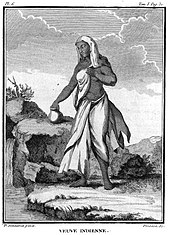| Hindu Widows' Remarriage Act, 1856 | |
|---|---|
 A widow in India (seen in this engraving from 1774–1781) was not allowed to wear a blouse or choli under her sari. The sari was required to be of coarse cloth, preferably white. | |
| |
| Repealed by | |
| THE WIDOWS' RE-MARRIAGE (REPEAL) ACT, 1983 | |
| Status: Repealed |
The Hindu Widows' Remarriage Act 1856, also Act XV, 1856, passed on 16 July 1856, legalised the remarriage of widows in all jurisdictions of India under East India Company rule. The law was enacted on 26 July 1856.[1] It was drafted by Lord Dalhousie and passed by Lord Canning before the Indian Rebellion of 1857. It was the first major social reform legislation after the abolition of sati pratha in 1829 by Lord William Bentinck.[2][3][4][5][6][7]
To protect what it considered family honour and family property, Hindu society had long disallowed the remarriage of widows, even child and adolescent ones, all of whom were expected to live a life of austerity and abnegation.[8] The Hindu Widows' Remarriage Act of 1856,[9] provided legal safeguards against loss of certain forms of inheritance for remarrying a Hindu widow,[8] though, under the Act, the widow forsook any inheritance due her from her deceased husband.[10] Especially targeted in the act were child widows whose husbands had died before consummation of marriage.
- ^ Cite error: The named reference
carroll-2008-p78was invoked but never defined (see the help page). - ^ Chandrakala Anandrao Hate (1948). Woman and Her Future. New Book Company. p. 156. Retrieved 16 December 2018.
- ^ Penelope Carson (2012). The East India Company and Religion, 1698-1858. Boydell Press. pp. 225–. ISBN 978-1-84383-732-9.
- ^ B. R. Sunthankar (1988). Nineteenth Century History of Maharashtra: 1818-1857. Shubhada-Saraswat Prakashan. p. 522. ISBN 978-81-85239-50-7. Retrieved 16 December 2018.
- ^ Mohammad Tarique. Modern Indian History. Tata McGraw-Hill Education. pp. 4–. ISBN 978-0-07-066030-4. Retrieved 17 December 2018.
- ^ John F. Riddick (2006). The History of British India: A Chronology. Greenwood Publishing Group. pp. 53–. ISBN 978-0-313-32280-8. Retrieved 17 December 2018.
- ^ Indrani Sen (2002). Woman and Empire: Representations in the Writings of British India, 1858-1900. Orient Blackswan. pp. 124–. ISBN 978-81-250-2111-7.
- ^ a b Peers 2006, pp. 52–53
- ^ Forbes 1999, p. 23
- ^ Cite error: The named reference
carroll-2008-p80was invoked but never defined (see the help page).